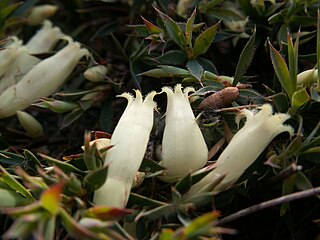
Styphelia pallida, commonly known as kick bush, is usually a small, compact shrub in the family Ericaceae. The species is endemic to south-western Western Australia.

Leucopogon pendulus is a species of flowering plant in the heath family Ericaceae and is endemic to the south-west of Western Australia. It is an erect, straggling shrub with oblong leaves and white, tube-shaped flowers that are bearded inside.

Styphelia planifolia is a species of flowering plant in the heath family Ericaceae and is endemic to the south-west of Western Australia. It is a bushy shrub with narrowly oblong or lance-shaped leaves with a small, sharp point on the tip, and white, tube-shaped flowers.

Styphelia flavescens is a species of flowering plant in the heath family Ericaceae and is endemic to the south-west of Western Australia. It is a shrub with oblong leaves and white, tube-shaped flowers that are densely bearded on the inside.

Styphelia glaucifolia is a species of flowering plant in the family Ericaceae and is endemic to the south-west of Western Australia. It is an erect or spreading shrub with linear, sharply-pointed leaves, and white, tube-shaped flowers.

Styphelia insularis is a species of flowering plant in the heath family Ericaceae and is endemic to the south-west of Western Australia. It is a rigid, scrubby shrub with many branches, linear or oblong leaves and tube-shaped, white flowers.

Styphelia leptantha is a species of flowering plant in the heath family Ericaceae and is endemic to the south-west of Western Australia. It is an erect, bushy shrub that typically grows to a height of about 30 cm (12 in). Its leaves are erect, oblong or egg-shaped and 4–6 mm (0.16–0.24 in) long with a small, hard point on the tip. The flowers are arranged singly or in pairs in leaf axils with small bracts and bracteoles less than half as long as the sepals. The sepals are about 1.6 mm (0.063 in) long, the petals joined at the base to form a tube about 4 mm (0.16 in) long with lobes about 2 mm (0.079 in) long.
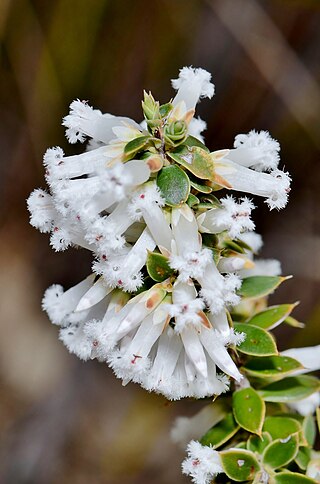
Styphelia erubescens is a species of flowering plant in the heath family Ericaceae and is endemic to the south-west of Western Australia. It is an erect shrub with variably-shaped leaves with a small, sharp point on the tip, and white, pink or red, tube-shaped flowers.

Styphelia capillaris, commonly known as Horts' styphelia, is a species of flowering plant in the heath family Ericaceae and is endemic to a small area of south-western Western Australia. It is a dense, spreading shrub with narrowly egg-shaped to narrowly elliptic leaves and white flowers arranged singly or in pairs in leaf axils.
Styphelia chlorantha is a species of flowering plant in the heath family Ericaceae and is endemic to a small area of Western Australia. It is a low, spreading shrub with erect, narrowly egg-shaped to egg-shaped leaves with the narrower end towards the base, and green, tube-shaped flowers arranged singly in leaf axils.
Styphelia densifolia is a species of flowering plant in the heath family Ericaceae and is endemic to the south-west of Western Australia. It is a shrub with erect branches, crowded, erect, oblong leaves 4–6.5 mm (0.16–0.26 in) long and striated on the lower surface, and white, tube-shaped flowers arranged singly in upper leaf axils.
Styphelia deserticola is a species of flowering plant in the heath family Ericaceae and is endemic to inland Western Australia. It is an erect shrub with sharply-pointed, narrowly egg-shaped leaves and white or pale cream-coloured, tube-shaped flowers usually arranged in groups of 2 or 3 in leaf axils.
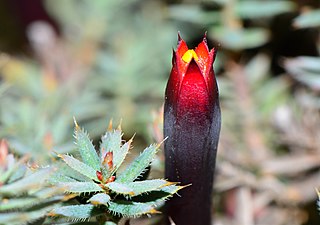
Styphelia discolor is a species of flowering plant in the heath family Ericaceae and is endemic to the south-west of Western Australia. It is a shrub, usually with prostrate stems and spreading, tapering linear leaves and almost sessile red flowers.

Styphelia erectifolia is a species of flowering plant in the heath family Ericaceae and is endemic to the south-west of Western Australia. It is a shrub with often wand-like, erect or ascending, usually softly-hairy branches and a thick, woody trunk. The leaves are linear, tapering to a short point, the edges turned down or rolled under and usually less that 12 mm (0.47 in) long. The flowers are red, and nearly sessile, with bracteoles about 2 mm (0.079 in) long at the base. The sepals are about 6.5 mm (0.26 in) long, the petal tube 8.6–11 mm (0.34–0.43 in) long with lobes 4 mm (0.16 in) long and bearded inside.
Styphelia filifolia is a species of flowering plant in the heath family Ericaceae and is endemic to the south-west of Western Australia. It is an erect shrub with erect, linear leaves, and white, tube-shaped flowers arranged singly, or in groups of up to four in leaf axils.
Styphelia inopinata is a species of flowering plant in the heath family Ericaceae and is endemic to the west of Western Australia. It is a robust, spreading shrub with hairy young branchlets and usually erect, narrowly elliptic, sharply-pointed leaves and reddish pink, very narrowly bell-shaped flowers, usually arranged singly in leaf axils.
Styphelia intertexta is a species of flowering plant in the family Ericaceae and is endemic to southern Western Australia. It is a much-branched shrub with woolly-hairy branchlets, narrowly triangular to linear, sharply pointed leaves, and white flowers with turned-back lobes that are bearded inside.
Styphelia longissima is a species of flowering plant in the heath family Ericaceae and is endemic to a few places in the south-west of Western Australia. It is an erect shrub with hairy young branchlets, stem-clasping, sharply-pointed, narrowly egg-shaped to narrowly elliptic leaves, and white, tube-shaped flowers.
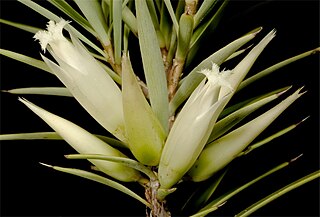
Styphelia macrocalyx, commonly known as Swan berry, is a species of flowering plant in the heath family Ericaceae and is endemic to the south west of Western Australia. It is a shrub with sharply pointed, narrowly lance-shaped leaves and white, tube-shaped flowers with tufts of hairs on the inside.
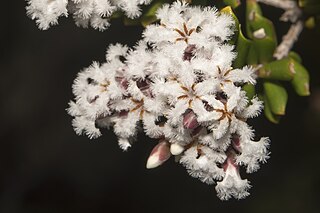
Styphelia melaleucoides is a species of flowering plant in the heath family Ericaceae and is endemic to the south west of Western Australia. It is an upright, spreading shrub with egg-shaped to almost round leaves and white, tube-shaped flowers bearded inside.













